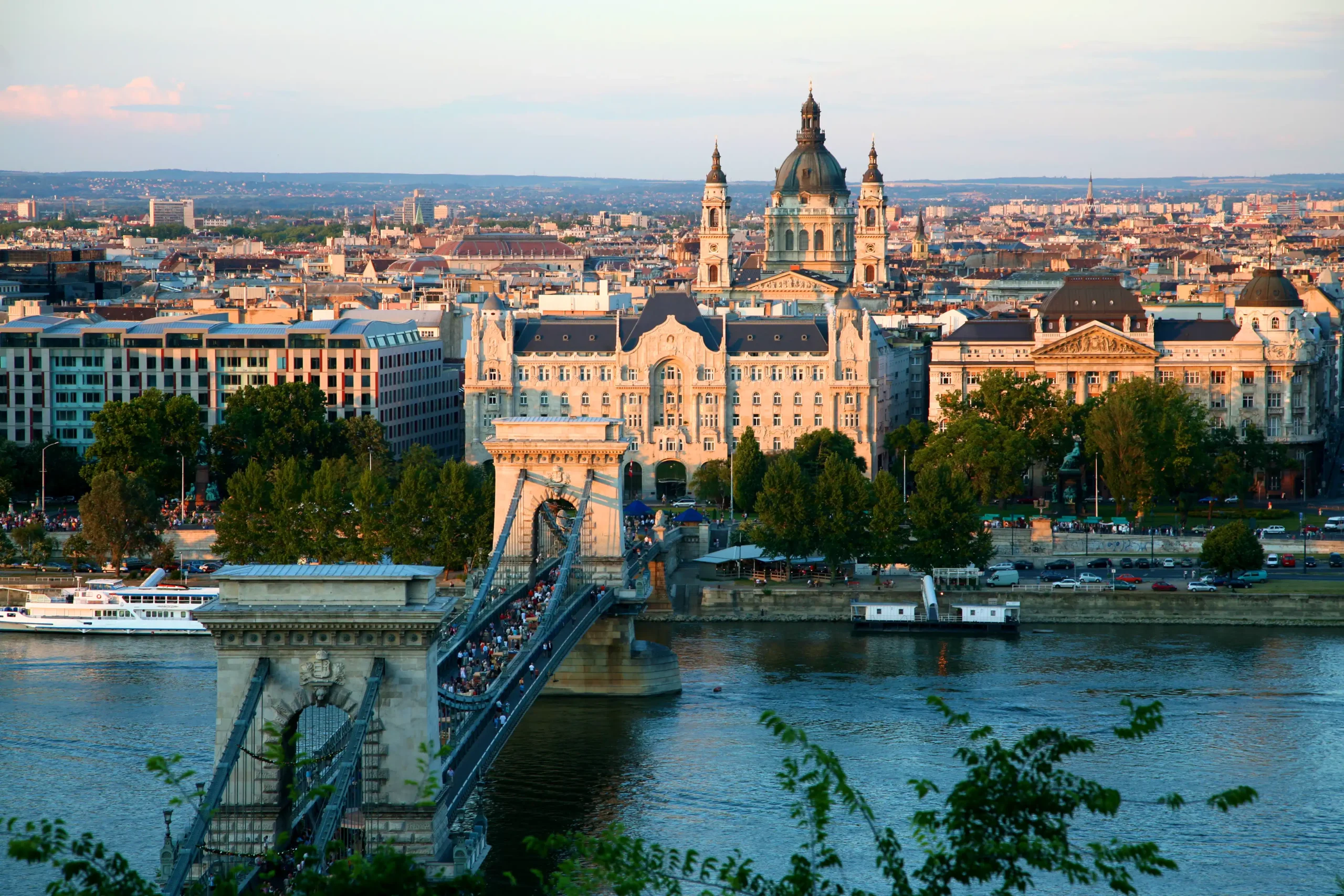
Embark on an enchanting city break to Budapest, where history, culture, and contemporary vibrancy converge to create an unforgettable experience. Nestled along the majestic Danube River, Budapest, the capital of Hungary, offers a world of architectural wonders, thermal baths, and a thriving culinary scene. In this guide, we’ll unveil the 10 best things to do, from exploring historic landmarks to indulging in the city’s renowned thermal spas. Additionally, we’ll guide you through the diverse neighborhoods and suggest ideal places to stay, ensuring your trip to Budapest is not only filled with cultural exploration but also provides the perfect home base for your urban adventure.
What Are The Best Things To Do On A Budapest City Break?
Budapest beckons travelers with its rich history, captivating architecture, and vibrant cultural scene. Embark on a journey of discovery as we unveil the city’s hidden gems and uncover the experiences that will make your city break an unforgettable adventure.
Buda Castle
Buda Castle, a UNESCO World Heritage Site, crowns Castle Hill in Budapest’s Buda side. This architectural marvel, with roots tracing back to the 13th century, served as the Hungarian kings’ royal residence.
Standing on the Danube’s western bank, Buda Castle anchors the historic Castle District, also home to Matthias Church and Fisherman’s Bastion. Its strategic perch affords panoramic views of the river and Pest, creating a mesmerizing backdrop for its cultural significance.
Visitors can access Buda Castle via various routes. One scenic option is the historic funicular from Clark Ádám Square, providing a picturesque ascent to Castle Hill. Alternatively, a leisurely stroll across the iconic Chain Bridge followed by a climb up Castle Hill offers a more immersive experience, taking you through charming cobblestone streets and medieval architecture.
Once atop Castle Hill, you can marvel at the Buda Castle Courtyard, adorned with statues and fountains, and delve into Hungary’s fascinating past at the Budapest History Museum. Explore the grandeur of the Hungarian National Gallery, showcasing an extensive collection of Hungarian art spanning centuries. Don’t miss the Matthias Fountain, a neo-Baroque masterpiece, and take a moment to absorb the breathtaking views of the Danube and the Parliament building from the castle terrace!
Central Market Hall
A culinary gem and cultural hub in Budapest’s heart, the Central Market Hall is a gastronomic paradise dating back to the 19th century. This bustling marketplace showcases Hungarian flavors, crafts, and traditions, encapsulating the city’s vibrant culinary and cultural scene. Along the Danube, this iconic market offers not only culinary delights but also panoramic views of the river and Gellért Hill on the Buda side.
Nestled at the southern end of Liberty Bridge, the Central Market Hall is easily accessible in the city center. Getting there is very convenient via public transport: the metro (M4) stops at Fővám tér, right outside the market. For those exploring on foot, the market is within walking distance from popular landmarks like the Great Synagogue and the Hungarian National Museum.
Once you’re there, prepare for a sensory feast. Stroll through stalls brimming with fresh produce, regional meats, and colorful fruits and vegetables, engaging with local vendors and sampling traditional Hungarian snacks. Oh, and head to the upper level for a journey into Hungarian culinary delights! Numerous stalls offer traditional dishes such as lángos (deep-fried flatbread) and goulash, providing an authentic taste of Hungarian cuisine.
Beyond food, the Central Market Hall houses stalls with Hungarian wines, sweets, and a variety of handicrafts. Explore each nook and cranny, and appreciate the architectural beauty of the building itself, characterized by its distinctive iron structure and vibrant roof tiles.
Vajdahunyad Castle
Vajdahunyad Castle, a captivating architectural masterpiece, is a fairytale-like structure nestled within Budapest’s City Park. Its enchanting design, originally built as a temporary exhibit for the 1896 Millennium Celebration, incorporates elements from various historical Hungarian architectural styles, making it an emblem of Hungary’s rich history and architectural diversity.
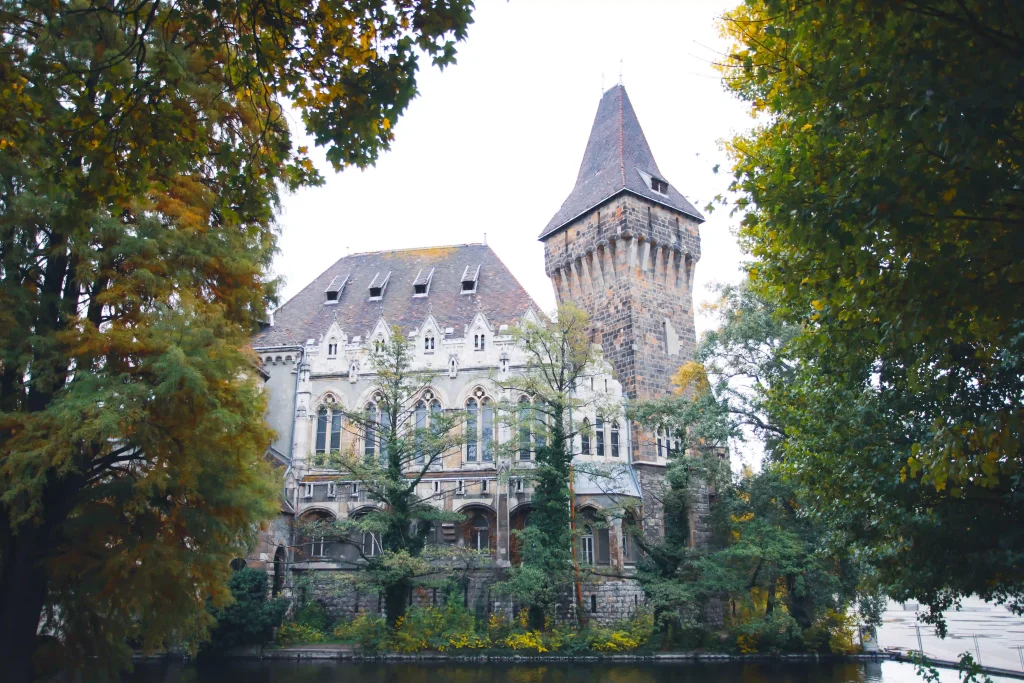
Conveniently located in the heart of City Park, Vajdahunyad Castle is easily accessible within Budapest. Visitors can take the metro to Széchenyi fürdő station (M1) or Heroes’ Square station (M1), or choose from numerous buses and trolleys that serve stops near City Park. For those who prefer a leisurely stroll, a walk through the park from the city center offers a scenic approach to the castle.
Upon entering the castle grounds, visitors are transported to a bygone era, with towers, turrets, and courtyards evoking a medieval atmosphere. The castle’s interior houses various exhibitions and museums, providing a fascinating glimpse into Hungary’s history and culture.
Chain Bridge
The Chain Bridge, or Széchenyi Chain Bridge, is an iconic landmark of Budapest that elegantly spans the Danube River, connecting the Buda and Pest sides of the city. Inaugurated in 1849, this historic suspension bridge holds great significance as the first permanent bridge to unite the two halves of Budapest, playing a pivotal role in the city’s development.
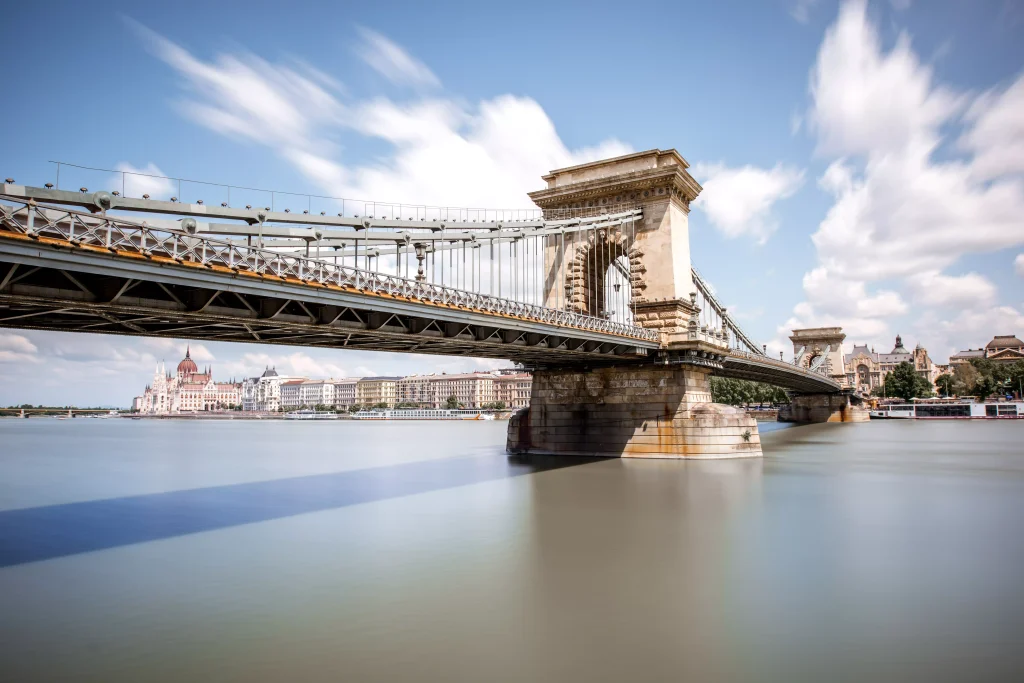
Centrally located in Budapest, the Chain Bridge connects Roosevelt Square in Pest with Clark Ádám Square in Buda. Its distinctive design and panoramic views make it not only a vital transportation link but also a must-visit attraction for tourists exploring the city.
Upon crossing the Chain Bridge, you’ll be rewarded with breathtaking views of the Danube River and the city’s skyline. The bridge’s pedestrian walkways provide ample space to admire the cityscape and capture unforgettable photos.
Stephen’s Basilica
St. Stephen’s Basilica, or Szent István-bazilika, stands as a magnificent Catholic cathedral and one of Budapest’s most iconic landmarks. Named after Hungary’s first king, St. Stephen, the basilica is renowned for its neoclassical architecture, stunning interior, and panoramic views from its dome, serving as a symbol of Hungary’s rich religious and cultural heritage.
Located in the heart of Budapest, St. Stephen’s Basilica graces the Pest side of the city, and is positioned near popular areas such as Deák Ferenc Square and the Danube Promenade, making it easily accessible for both locals and tourists.
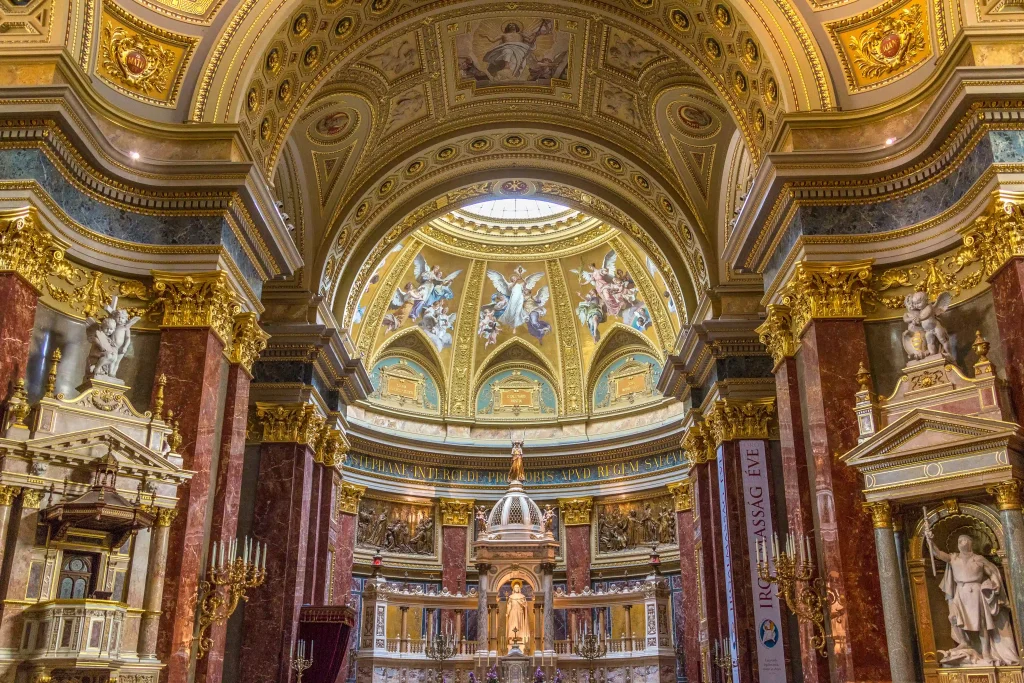
To reach St. Stephen’s Basilica, visitors can use public transportation, with nearby metro stations such as Deák Ferenc tér (M1, M2, M3) and Arany János utca (M3). Buses and trams also serve stops in the vicinity. For those exploring on foot, the basilica is within walking distance from several key attractions and neighborhoods.
For a breathtaking perspective of the city, visitors can ascend the basilica’s dome, offering panoramic views of Budapest’s skyline, the Danube River, and the surrounding hills. The climb is well worth the effort, providing a unique glimpse of the city’s beauty and grandeur.
Fisherman’s Bastion
Nestled on Castle Hill in Budapest’s Buda side, Fisherman’s Bastion is a mesmerizing architectural gem that showcases the city’s grandeur. This neo-Gothic and neo-Romanesque terrace, built in the late 19th century, offers panoramic views of the Danube River, the Pest side of the city, and the iconic Parliament building.
Part of the Castle District (Várnegyed), Fisherman’s Bastion is conveniently located next to Matthias Church, another notable landmark. This enchanting terrace is a highlight within walking distance of Buda Castle and the Matthias Church.
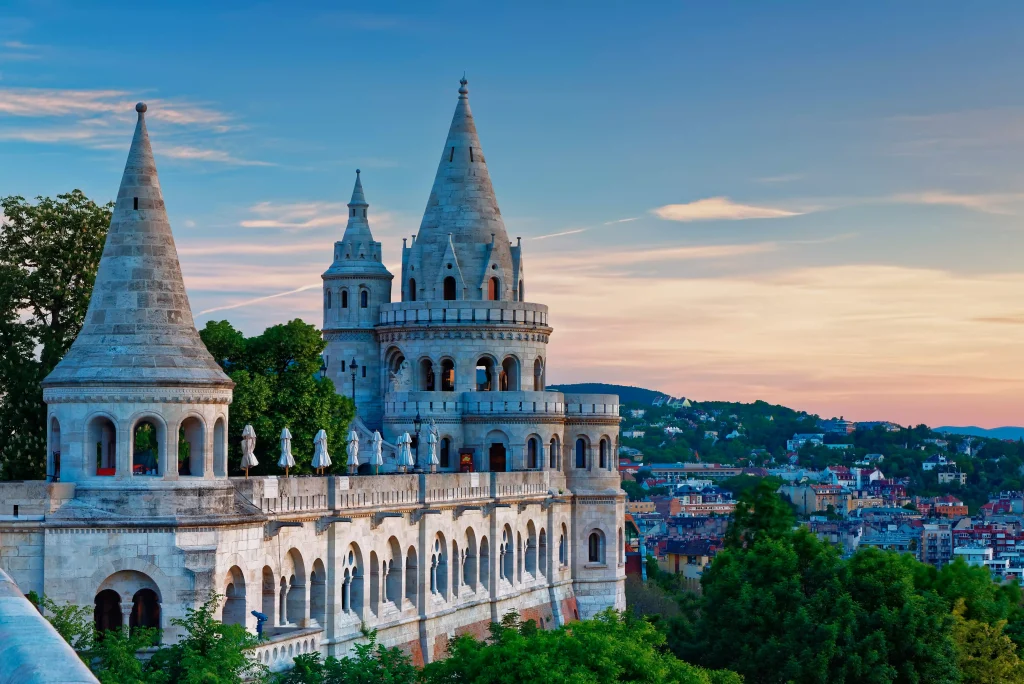
Reaching Fisherman’s Bastion is an enjoyable experience: visitors can choose to walk up Castle Hill from the Chain Bridge, providing a scenic ascent through Budapest’s charming cobblestone streets and historic architecture. Alternatively, the historic Castle Hill Funicular from Clark Ádám Square offers a more leisurely option.
Beyond its panoramic views, Fisherman’s Bastion is a work of architectural art in itself. Its intricate stonework, inspired by medieval fortifications, evokes a sense of timelessness. The seven towers, representing the seven Magyar tribes who founded Hungary, stand as proud sentinels overlooking the city.
Heroes’ Square
Heroes’ Square, or Hősök tere, is a monumental public space in Budapest, Hungary, celebrating the nation’s history, culture, and national identity. The square is adorned with statues and monuments dedicated to significant historical figures and events, creating a powerful tribute to the nation’s heritage.
Situated at the end of Andrássy Avenue, Heroes’ Square is located on the Pest side of Budapest. Its address is Hősök tere, 1146 Budapest, Hungary. The square is part of City Park and is easily accessible by various means of transportation: you can use the metro, with the closest station being Hősök tere (M1). Buses and trolleys also serve stops in the vicinity, and for those who prefer walking, a stroll along Andrássy Avenue adds to the experience, showcasing the avenue’s architectural beauty.
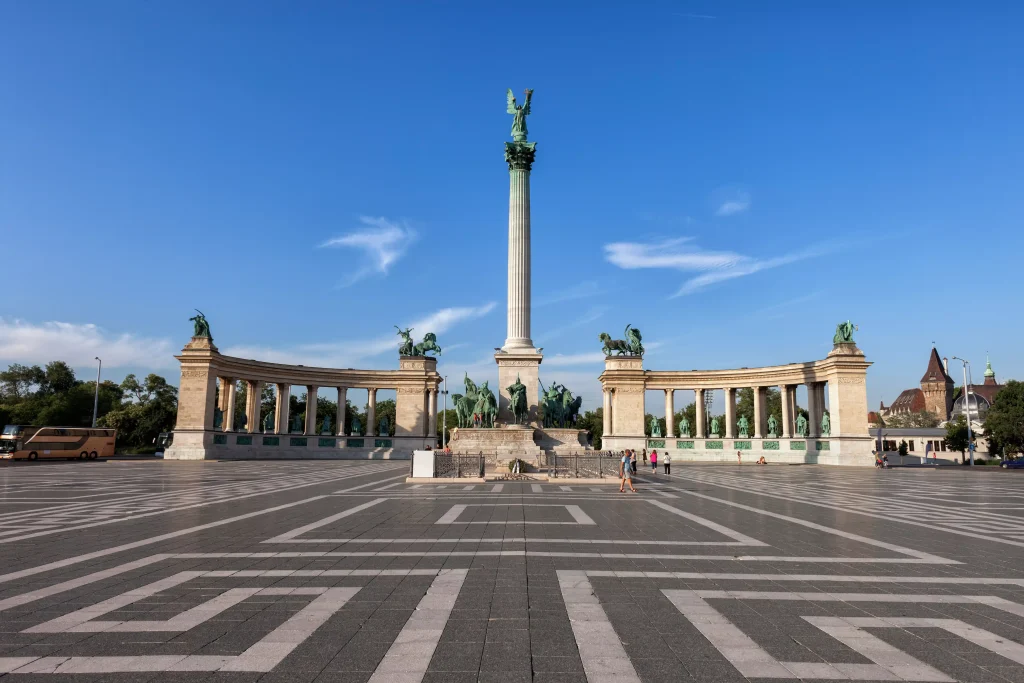
The central Millennium Monument, a 36-meter-tall column topped by a statue of the Archangel Gabriel, stands as a symbol of Hungary’s thousand-year history. Surrounding the monument are two semicircular colonnades, each lined with statues of prominent Hungarian rulers and leaders.
Heroes’ Square is not just a historical landmark; it’s a living space that plays a vital role in Budapest’s cultural landscape. Throughout the year, the square hosts various events, from concerts and festivals to national celebrations!
Hungarian Parliament Building
The Hungarian Parliament Building, or Országház, stands as a magnificent architectural masterpiece, gracing the banks of the Danube River in Budapest. This neo-Gothic landmark, a symbol of Hungary’s political and cultural heritage, ranks among the largest parliamentary buildings globally. With its grandeur, intricate details, and strategic location, the Parliament Building beckons visitors to explore its beauty.
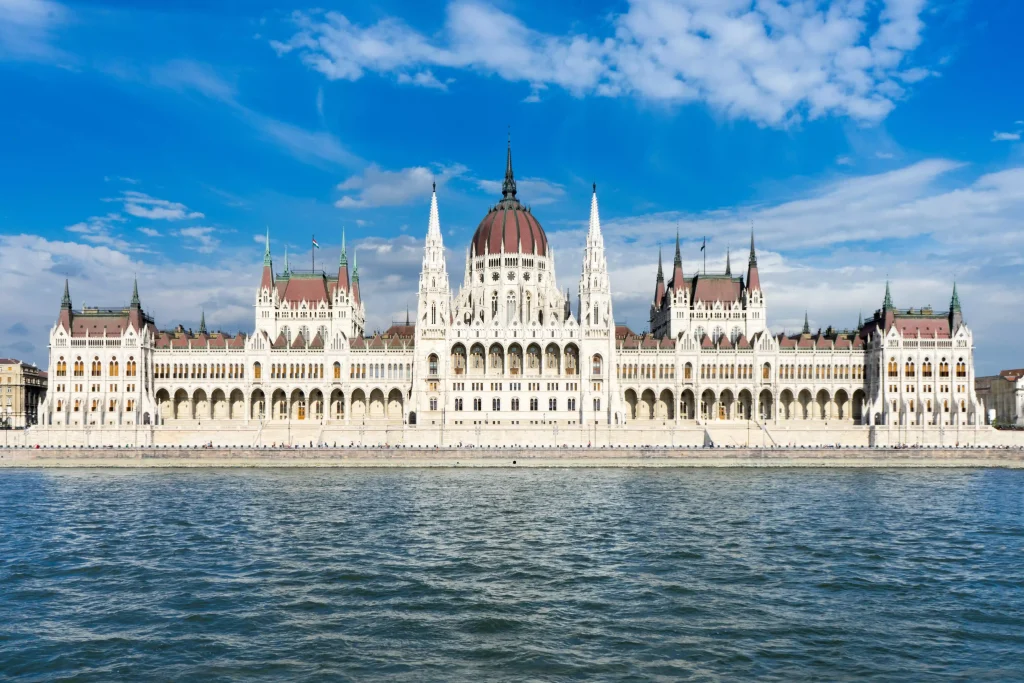
The Parliament Building’s prominent position, facing Buda Castle and overlooking Margaret Island, makes it a central and easily recognizable feature of the city’s skyline. Public transportation options abound, with nearby tram stops and metro stations, such as Kossuth tér (M2), providing easy access. Other than that, a walk along the Danube Promenade from central areas like Vörösmarty Square offers scenic views and a delightful approach to the Parliament Building.
A visit to the Hungarian Parliament Building is an immersive experience that blends architectural beauty, historical significance, and cultural insights. Whether you’re an architecture enthusiast, a history buff, or simply seeking a captivating landmark to explore, the Parliament Building stands as a must-visit destination in Budapest.
Thermal Baths
Immerse yourself in the therapeutic and relaxing world of Budapest’s thermal baths, where natural hot springs have been integrated into Hungarian culture for centuries.

Budapest boasts three main thermal baths, each with its unique ambiance and offerings:
- Széchenyi Baths: Located in City Park, Széchenyi is the largest thermal bath in Budapest, renowned for its expansive outdoor pools and neoclassical architecture. Address: Állatkerti krt. 9-11, 1146 Budapest, Hungary.
- Gellért Baths: Nestled at the foot of Gellért Hill on the Buda side, Gellért Baths is an architectural gem known for its stunning Art Nouveau style and panoramic views of the city. Address: Kelenhegyi út 4, 1118 Budapest, Hungary.
- Rudas Baths: Situated right by the Danube on the Buda side, Rudas Baths is one of the oldest thermal baths in Budapest, offering a traditional Turkish bath experience with separate men’s and women’s sections. Address: Döbrentei tér 9, 1013 Budapest, Hungary.
Budapest’s efficient public transport system makes it easy to reach these thermal baths:
- Széchenyi Baths: Metro (M1).
- Gellért Baths: Tram 19 or 49.
- Rudas Baths: Bus or a pleasant walk from the city center.
Immerse yourself in the healing waters and revitalizing atmosphere of Budapest’s thermal baths, where tradition meets modern wellness, offering a diverse range of options for relaxation, therapeutic benefits, and social enjoyment.
Pálvölgyi Cave
Pálvölgyi Cave is a captivating subterranean labyrinth that extends beneath the Buda Hills. This natural wonder, with its intricate passages, unique rock formations, and rich biodiversity, offers visitors a glimpse into the hidden world beneath Budapest.
To reach Pálvölgyi Cave, take bus 65 or 165 from Széll Kálmán tér (formerly Moszkva tér) to the Pálvölgyi Cave bus stop – the cave entrance is a short walk from the bus stop. For those driving, a parking lot is available near the cave entrance – follow the signs to Szépvölgyi út and use GPS coordinates for precise navigation.
Embark on a journey through Pálvölgyi Cave’s wonders with guided tours led by experienced cavers. These tours provide insights into the cave’s formation, geology, and history, while ensuring a safe and informative experience for visitors of all ages. Explore the cave’s labyrinthine passages, marvel at its unique rock formations, and discover the rich biodiversity that thrives in this subterranean world!
What To Do In Budapest At Night?
As the sun dips below the horizon, Budapest transforms into a vibrant hub of nocturnal activities, offering an array of captivating experiences to suit every taste. Whether you seek vibrant parties, cultural immersion, or serene moments by the river, Budapest’s nightlife promises unforgettable after-dark adventures.
- Visit Ruin Bars in District VII: Explore the unique ruin bars scattered throughout the historic Jewish Quarter. These bars are set in abandoned buildings, creating a distinctive atmosphere with eclectic decor and a lively crowd!
- Night Cruise on the Danube: Enjoy the breathtaking views of Budapest illuminated at night with a Danube River cruise. Many operators offer evening cruises with dinner, allowing you to admire the city’s landmarks, including Buda Castle and the Parliament Building, while drifting along the river.
- Take a Stroll Along the Danube Promenade: The Danube Promenade offers a romantic setting for an evening walk. Admire the beautifully lit Chain Bridge, Buda Castle, and the Parliament Building. Street performers often add to the lively ambiance.
- Experience Thermal Baths at Night: Gellért Baths and Széchenyi Baths, among others, extend their opening hours, allowing visitors to relax in the thermal pools under the stars. It’s a unique and tranquil way to unwind after a day of exploration.
- Enjoy Live Music and Concerts: Budapest boasts a thriving music scene. Attend a classical concert in the stunning surroundings of St. Stephen’s Basilica, or immerse yourself in the local music scene by checking out jazz clubs, bars with live bands, or electronic music venues.
- Savor Hungarian Cuisine at a Night Market: Budapest occasionally hosts night markets where you can sample local dishes, snacks, and beverages. These markets often feature live music, creating a festive atmosphere.
- Climb Gellért Hill for Panoramic Views: Take a nighttime hike up Gellért Hill to the Citadel for panoramic views of Budapest. The city’s illuminated skyline is a breathtaking sight, and the peaceful surroundings offer a welcome escape.
- Attend a Cultural Performance: Book tickets to a cultural performance, such as a traditional Hungarian folk dance show or an opera performance at the Hungarian State Opera House. These events showcase the rich cultural heritage of Budapest.
Where To Shop In Budapest?
Budapest offers a delightful shopping experience with a mix of traditional markets, trendy boutiques, and bustling shopping streets. Two must-visit locations for shopping enthusiasts are Váci Street and Andrássy Avenue!
Váci Street
Váci Street is one of Budapest’s most iconic shopping destinations, situated in the heart of the city. This pedestrian-friendly street is lined with a plethora of shops, ranging from international brands to local boutiques. It’s the perfect place to find fashion, jewelry, souvenirs, and Hungarian specialty products. Take a leisurely stroll along Váci Street, explore the charming side alleys, and indulge in a shopping spree while enjoying the vibrant atmosphere of this bustling area.
Andrassy Avenue
For a more upscale shopping experience, head to Andrássy Avenue. This elegant boulevard is not only renowned for its stunning architecture and cultural sites but also for its high-end boutiques and designer stores. Here, you’ll find fashion houses like Louis Vuitton, Gucci, and Chanel, as well as luxury Hungarian brands. Andrássy Avenue is not just a shopping destination; it’s a cultural experience, with theaters, cafes, and historical landmarks adding to the avenue’s allure. Take your time to explore the boutiques and soak in the sophistication of this iconic avenue.
Other Options
In addition to these main shopping streets, Budapest offers a range of other shopping experiences. The Great Market Hall (Nagyvásárcsarnok) is perfect for those looking to explore traditional Hungarian foods, spices, and crafts. For a mix of international and local brands, head to WestEnd City Center, one of the largest shopping malls in Central Europe.
How To Get Around Budapest?
Getting around Budapest is convenient and efficient with its well-developed public transportation system. However, renting a car can be beneficial for those seeking to explore beyond the city limits and immerse themselves in the Hungarian countryside.
With a rental car, you can venture to destinations like the scenic Danube Bend or the charming wine regions surrounding Budapest at your own pace. You can also make spontaneous detours to hidden gems and off-the-beaten-path attractions.
A rental car is also advantageous if you plan to visit rural areas or explore Hungary’s national parks. While public transportation is efficient in Budapest, a rental car opens up a world of possibilities for those seeking a more personalized and adventurous travel experience.
When considering renting a car in Budapest, Rentcars offers a user-friendly platform that allows you to compare prices from various rental agencies. With a diverse range of vehicles available, Rentcars provides flexibility to suit your travel needs. The booking process is straightforward, and customer reviews help you make informed decisions about your chosen rental. Rentcars also offers convenient pick-up and drop-off locations at the airport or city center, making it an excellent choice for those looking to explore Budapest and its surroundings with comfort and efficiency!
Where to Stay in Budapest?
Ultimately, the best area to stay depends on your preferences, interests, and the type of experience you seek. Here are some neighborhoods and city areas in Budapest, each with its unique charm:
- District V (Belváros-Lipótváros – Inner City)
Ideal for first-time visitors as it is in the heart of the city! It is close to major attractions like Parliament, St. Stephen’s Basilica, and the Chain Bridge. Offers a mix of upscale hotels, boutique accommodations, and apartments.
- District VII (Erzsébetváros – Jewish Quarter)
Known for its vibrant and eclectic atmosphere, and home to the historic Jewish Quarter, with ruin bars, street art, and a lively nightlife scene. Great for those looking for a bohemian and cultural experience!
- District VI (Terézváros – Teréz Boulevard)
Features the elegant Andrássy Avenue, a UNESCO World Heritage site, and is close to the Opera House, Heroes’ Square, and City Park! Offers a mix of luxury hotels, budget accommodations, and stylish boutiques.
- District I (Várkerület – Castle District)
Situated on the Buda side of the Danube, overlooking Pest, this District is home to Buda Castle, Matthias Church, and Fisherman’s Bastion, and provides a more historic and quieter atmosphere.
- District IX (Ferencváros – District of Ferenc)
Located south of the city center, along the Danube, it is known for its market hall, local eateries, and cultural diversity! Offers a more relaxed environment away from the tourist crowds.
- District XIII (Angyalföld – Angel’s Place)
Positioned along the Danube on the Pest side, this district features Margaret Island, a peaceful recreational area, and offers a mix of modern apartments and hotels.
- District XI (Újbuda – New Buda)
A residential area with good public transportation connections, close to Gellért Hill and the Gellért Baths. It provides a more local and less touristy feel.
Frequently asked questions
How Is The Climate In Budapest?
Budapest’s diverse and continental climate, influenced by its location in the Carpathian Basin, offers four distinct seasons: spring, summer, autumn, and winter.
Spring brings a gradual warming trend, with temperatures ranging from mild to warm, ideal for sightseeing. Summer brings the city’s warmest months, with July typically the hottest, reaching around 82-86°F (28-30°C).
Autumn offers mild weather, making it another ideal time for sightseeing, and winter brings chilly temperatures, often dipping below freezing. While snowfall is not guaranteed, the occasional dusting adds to the winter’s charm.
What Is The Best Time of the Year to Visit Budapest?
Choosing the best time to visit Budapest depends on your preferences and the type of experience you’re seeking. If you prefer milder weather and fewer crowds, consider spring or autumn. For those who enjoy warmth and a lively atmosphere, summer is the ideal time. Meanwhile, winter offers a unique and festive experience.
Do I Need Passports And Visas to Visit Budapest?
If you’re planning a trip to Budapest, Hungary, ensure you have a valid passport. Depending on your nationality, you may also need a Schengen visa. Check with the Hungarian consulate or embassy in your country for visa requirements and application procedures.
Do I Need Travel And Medical Insurance to Visit Budapest?
While it may not be a mandatory requirement, investing in travel and medical insurance is a responsible and prudent decision that can enhance your overall travel experience and protect you from potential financial challenges during your visit to Budapest.
What Is The Language Spoken In Budapest?
While Hungarian is the official language of Budapest, English is widely understood and spoken, especially in tourist areas and among the younger generation. While learning a few basic Hungarian phrases can deepen your cultural immersion, you’ll find that English is sufficient for navigating the city and interacting with locals.







Leave a Reply